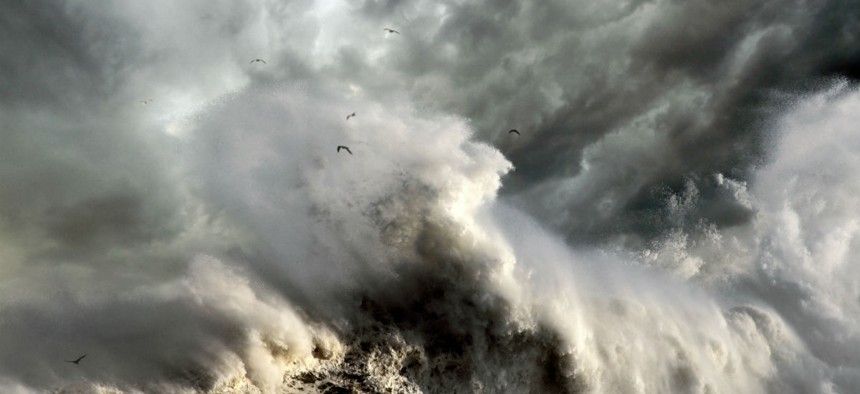Trump’s Category 5 Storm
What will hit first in 2018, the tsunami of a very big policy revolution or the legal waves that could submerge Trump’s presidency?
Donald Trump hit Washington a year ago like a Category 5 hurricane—a fierce hurricane with a very small eye. Despite the tsunami of headlines that have followed, Trump’s actual impact on most of the federal government was actually pretty slight in his first year.
In some agencies, like the State Department, the Environmental Protection Agency, and the Federal Communications Commission, the shock has been enormous. But for most federal employees, the impact has been curiously distant: something that has produced a sense of unease, fed by news stories, but which hasn’t really affected them or their jobs.
Below the top level or two of most agencies, the work of the federal government has gone on pretty much as before. Federal employees administer the law, and most of the laws haven’t changed. They work with the money Congress appropriates, and the unhealthy roller coaster ride of continuing resolutions has continued at pretty much the same level of craziness as during the Bush and Obama administrations.
And it’s important to remember that 85 percent of all federal employees work outside Washington. They still go to work every day, managing air traffic, caring for veterans, helping taxpayers file their returns, answering questions about Social Security benefits, and ensuring that the national parks remain the wondrous places they are. For most of them, the Trump hurricane has affected them as it’s affected most Americans who work outside Washington—as a landfall event on Pennsylvania Avenue, with the long-term impacts yet to be felt.
In fact, one of the most important things about Trump’s first year is that, despite his pledge to “drain the swamp” and Steve Bannon’s promise to “deconstruct the administrative state,” the administrative state hasn’t changed, and Washington is about as swampy as Trump found it. It’s been a Cat 5 with a small eye—enormous impact in a very concentrated space.
But all of that is about to change in the new year. Consider these big waves preparing to strike.
Political appointees. After an historically slow start, the president is beginning to catch up on the job of getting his appointees into key positions. The Partnership for Public Service’s Political Appointee Tracker shows that Trump continues to lag behind every administration in recent memory. But the administration is getting more appointees in key positions and they’re beginning to have an impact, from the decision on net neutrality at the FCC to drug regulations at the FDA.
Judges. The Trump administration has been remarkably successful, thanks to Republican control of the Senate, in reshaping the federal judiciary. In his first year, he’s placed four times as many appointees on the appellate bench as Obama managed in his first year—and more than any president, ever.
The 2019 budget. The funding plan the president will release early in early February will be his first real budget. The administration’s transition was so badly organized this time last year that Trump lost the chance to put his stamp on the fiscal 2018 budget. But what’s about to come will clearly define how Trump plans to reshape the federal government. He might not get far—insider betting is that even most Republicans will treat the FY19 budget as dead on arrival and that the president will have a hard time pushing most of his cuts through. But even that might work to his advantage. It will give him a chance to put space between the White House and Capitol Hill, should he decide later to run against Congress in 2020. That might be especially handy if the Democrats take control of one (or both) branches.
A management plan. A sleeper could arise from the reform plans agency officials put together during the spring and summer of 2017. The president asked agencies to rethink how they do their work—and what work they might no longer need to do. Many agency plans emerged from the work of senior career officials, left home alone when the administration was slow in making political appointments. It will be worth watching the management agenda very carefully. There could be some very big things there.
The civil service. If most federal workers have been relatively untouched so far, that might change very soon. The White House has already indicated that the president will not seek a salary increase for federal employees in the coming year. And the president is serious about weakening the ability of federal employee unions to represent their members on government time. Members of the House, in particular, are keen to convert as much of the federal workforce to at-will employment, as quickly as possible. They’ve taken a page from the Wisconsin playbook: weaken the unions and cut public employees.
Entitlements. The Republican tax reform plan has evolved into an enormous starve-the-beast strategy. With mega-deficits sure to increase in the coming decade, Congressional Republicans have the ammunition they’ve been looking for to slash entitlements like Medicare, Medicaid, Social Security, and welfare. While Trump knows the political risks of so directly going after benefits important to his base, these programs are on the block for 2018 in a way that could scarcely have been imagined a year ago.
The coming months are likely to produce a sea change in the Trump presidency. Tax reform was not only a long-awaited policy win for the president and Republicans, it marks a pivot point.
Of course, Robert Mueller’s investigation might destabilize, distract, derail, or destroy Trumpmania. The impact of that investigation on the presidency remains uncertain. Congress also faces a long list of legislation it must pass, or at least must debate: another round of spending bills, an extension of the debt ceiling, immigration and DACA, and more death-by-a-thousand-cuts decisions on Obamacare. Any of these could erode the fragile Republican majority.
Thus, the first months of 2018 will be a race for what will hit first: the tsunami of a very big policy revolution or the legal waves that could submerge Trump’s presidency. It all depends on whether the Category 5 eye of Hurricane Trump expands—or whether it remains fierce but concentrated.
Without vocal leaders and a clear strategy, these forces are largely out of the Democrats’ control. They have little choice but to ride their ship wherever the hurricane’s winds take them. But those winds will be fierce, wild, and unpredictable.








